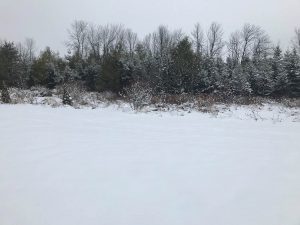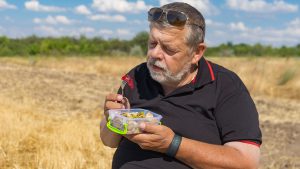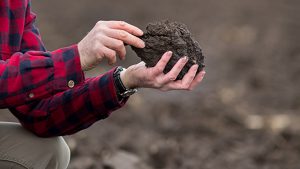Water management
PRODUCING THE BEST GRAIN CROP POSSIBLE
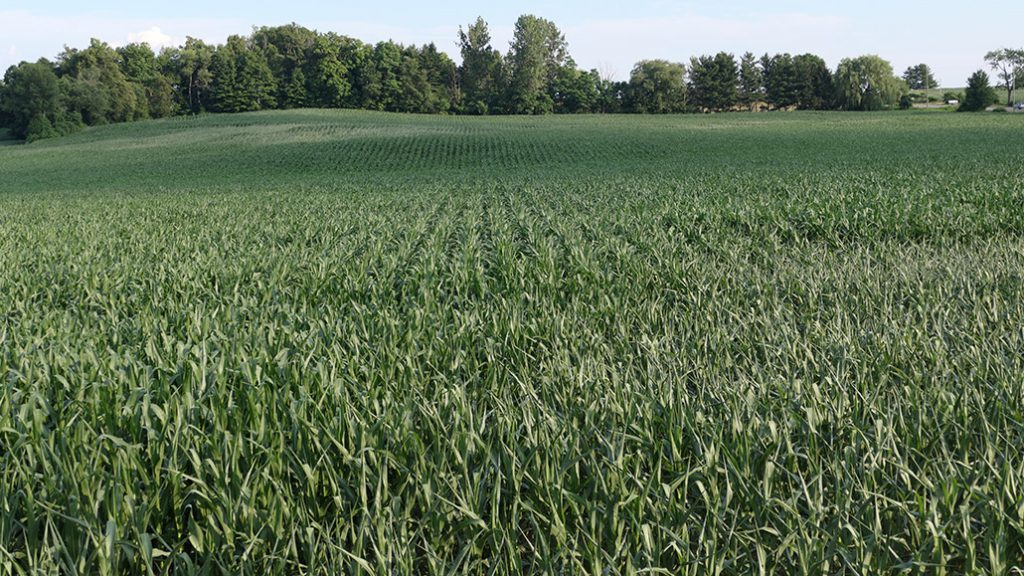
WATER AND SUNLIGHT are the ultimate crop inputs — even the efficiency of all other inputs is directly impacted by them. We can’t manage the amount of sunlight over our fields, but we can manage water.
So why don’t we?
It’s a question most grain farmers don’t give much thought to unless they are worried about getting water out of their field so they can plant a crop. And then, they rely on a hope and a prayer to get the rainfall they need when they need it.
Rainfall patterns in Ontario have become a series of infrequent, poorly distributed, and often intense rain events. We need the soil to be able to absorb rainfall in-season, so we have access to that water for crop growth; and we need to reduce surface water movement off the field in the non-growing season to reduce erosion and prevent pollution. To do this, we need to start including water in our overall management system.
With advancements in technology, crop management is evolving from the farm scale to field scale, to management zones, and eventually we will be able to manage at an individual plant level. The same tools that we have to understand the spatial aspect of individual fields (how soil properties change from one square metre to the next) can be utilized to manage water. Many management choices appear to be whole field strategies, but they should be tailored to suit specific areas within a field.
TILE DRAINAGE
Tile drainage is being used more frequently as a means to remove water in the spring and fall. Much of this is splitting tiles already in the landscape. While expensive, it is an easy and effective decision; but it is only one component of a year-long water management system.
Simply getting the water off the field doesn’t address all the other issues about how to make water available to the crop during the growing season. As well, with all the tile “splitting” occurring, you need to ask yourself if you need that new tile because the old tile just isn’t working anymore. If that tile was working before but less so now, something else in your management is negatively impacting the system. If we don’t change other components of the system, how long is it going to be until this big investment in more tile is compromised?
Farmers should consider systems such as contour drainage or controlled drainage which can increase the amount of water in the soil bank, but still allow you to plant under the right soil conditions. Shallower tiles can help keep water up near crop roots, but a narrower spacing may be needed to get uniform drainage between tile runs. Eventually we may see systems that drain water from fields and retain it onsite to return to the landscape as it is needed through the growing season.
COMPACTION AND EROSION
Management decisions which prevent compaction and control erosion will create a field environment which manages water and optimizes crop production potential.
Lower parts of a field, where water tends to accumulate, have tremendous yield potential. Often these highly productive areas are waterlogged in spring and are slower to dry, making them more susceptible to compaction since they will get worked when still wet when the rest of the field is dry. Your best part of the field is thus compromised.
Soils that are compacted will have reduced pore spaces. They have less space to hold water but at the same time are slower to drain, slower to dry, and slower to warm as it takes longer and more energy to get warmth into water than air. If compaction removes all the air, this process takes much longer.
Modern farm equipment is often big and heavy. Farmers should create a parking, headland, and in-field traffic management plan for fields to reduce the frequency and extent of travel across a field to reduce soil compaction potential, particularly in the shoulder seasons when soil conditions tend to be marginal. This saves money on equipment purchases, operating costs, wear and tear, and ensures your soil has the best chance of resisting compaction and erosion.
Reducing tillage intensity and the number of passes keeps soil consolidated, enhances soil microbial life, increases soil organic matter, increases water holding capacity, reduces soil erosion, and saves you money. A lot of tillage is being used for residue management with the big yield crops we have today. The right tillage (single pass vertical cutting) at the right time (spring), or other technologies (such as row clearers) can reduce the need for aggressive fall tillage and excessive spring tillage. Tillage reduces aggregation, burns organic matter, and makes soils much more susceptible to compaction, crusting, and erosion.
To further reduce compaction, install as much rubber (tires or tracks) under your equipment as possible. Sometimes this can encourage replacing equipment with new equipment that is designed to increase the rubber footprint and reduce the weight per unit area exerted on the soil.
Tire pressure is a related management consideration. Check your tire pressures and match them to the load and operation. Using technology such as central tire inflation systems (CTIS) can further reduce the impacts of equipment weight. It can also reduce fuel consumption, improve tire life, and make road travel much safer (with higher tire pressure to reduce the instability from under-inflated tires) and can reduce the compaction potential by greatly lowering tire pressure during field operations.
Where soil compaction has occurred, farmers should determine a management strategy and only work problem areas if necessary. Deep ripping or other tillage tools may help alleviate soil compaction, but you must be very conscious of the potential to drive compaction even deeper with subsequent field travel. You should avoid driving over soils that have been deep tilled for a significant time. Even better, establish a cover crop with lots of small roots than can stabilize a soil after deep tillage.
OTHER FACTORS
Any strategy that will increase soil porosity, increase organic matter, and decrease the potential for erosion will help store water in the soil during the season. Increasing soil porosity will help water flow freely to facilitate drainage during the shoulder seasons, and cover crops in shoulder seasons will help stabilize soils. Understanding good soil structure and applying management to optimize it should lead to rewards in productivity and profitability.
Limit high weight operations, including soil amendment and fertilizer application, to times of the year that are less susceptible to soil compaction. Timing these operations in mid-summer after forages or cereals greatly reduces the risk of soil compaction. However, they require a crop rotation that incorporates summer harvested crops. Furthermore, applying these inputs on top of green cover helps take up the nutrients and prevent erosion losses which are more likely in the absence of living plants.
Adding a summer harvested crop means there is more time where the field is exposed to wind and rain so incorporating cover crops can help keep soil in the field during the extended shoulder season for these crops. Incorporate winter crops including cereals, forages, and canola that keep living plants in place throughout the entire growing season and whose presence reduces erosion and feeds soil life. The goal is to have a living crop in the field for as much of the year as possible.
Farmers should target organic amendments to specific parts of the field that will benefit from them the most, often this is eroded knolls that don’t hold moisture well. These areas are historically depleted of organic matter because of tillage erosion and dry soils.
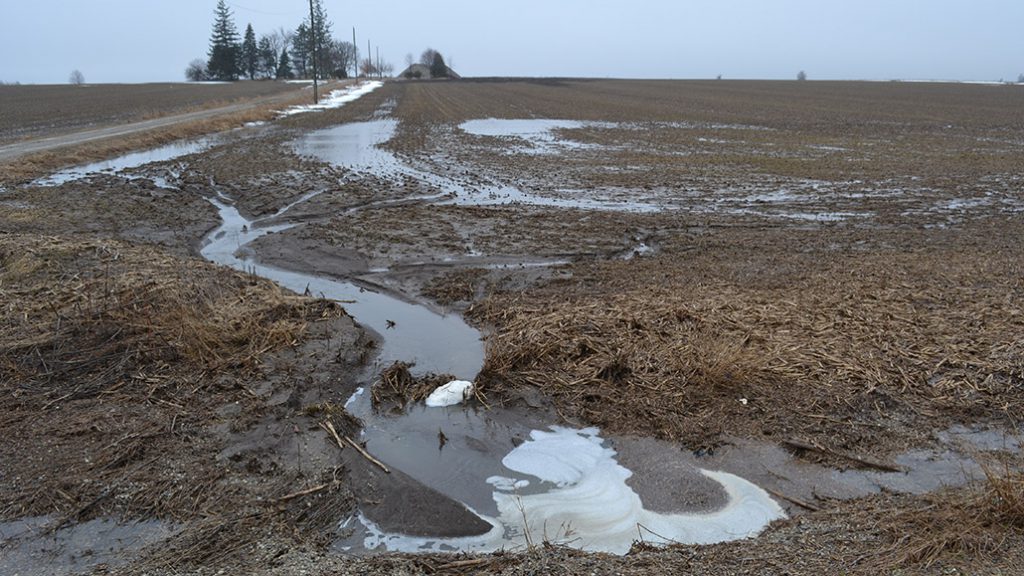
Scale labour, equipment, and land base so that you can make timing work relative to soil conditions in spring and fall. More equipment can cover the same land in shorter time, giving the field an opportunity to dry out before it is worked.
Waiting for late fall corn to dry down often leads into weather that makes soil unfit to be travelled on. Match hybrid maturity selection to the appropriate season and location. Harvesting and drying earlier often pays off in the long run relative to the damage done by mudding out late fall crops.
Explore crop share agreements with livestock neighbours to get forages into your rotation. This often can be done by swapping land for short periods of time, letting the livestock producer grow and harvest the forages on your land while you grow and manage grain crops on their land.
Hay is becoming a bigger crop opportunity. Custom harvesters are often available, so you don’t have to invest in all the equipment. Agreements are cropping up where fall seeded timothy is harvested late May and soybeans are quickly planted. This can be done by the farmers themselves, or custom done, or share relationships where the grain farmer takes over after the hay producer has harvested the timothy.
MAPPING
Management is becoming something that needs to be applied spatially because the field environment can vary so much within field boundaries. This is especially true as field size increases and now we are managing large fields that don’t have the same field history.
Farmers should consider an investment in profitability mapping that will highlight spatially the economic potential of the variability of your fields. Often people who have employed this have been shocked at how much these unproductive areas of their fields are costing them. Make the decision to retire those parts of the field into perennials crops that may be harvested for forage or just left as wildlife habitat. This is a tough concept for many farmers but those that have employed it have found themselves better off because their overall Return on Investment (ROI) for that field has improved.
Using the right tools to determine this landscape variability and take advantage of it is the next big step in crop production. While we have started down this path, we need to think about it more in terms of water management in the field and how to understand and exploit it.
Go to www.ontariograinfarmer.ca for a more detailed look at a real-world field comparison, where we walk through some topographic maps and explain water availability across two different fields in Wellington County with contrasting soil-landscape features.
For more information on soil structure and soil management best management practices, go to: http://www.omafra.gov.on.ca/english/environment/bmp/soil-health.htm. •
Other articles in the series:
• Producing the best grain crop possible (September 2020)
• The water cycle and why should we care (October 2020)
• The role of farm drainage (November 2020)
• Improvements through soil health (December 2020)
• A second look at farm drainage (January 2021)
• Is irrigation of grain crops feasible (February 2021)
• Irrigation case study (March 2021)
• Understanding groundwater (April/May 2021)


















